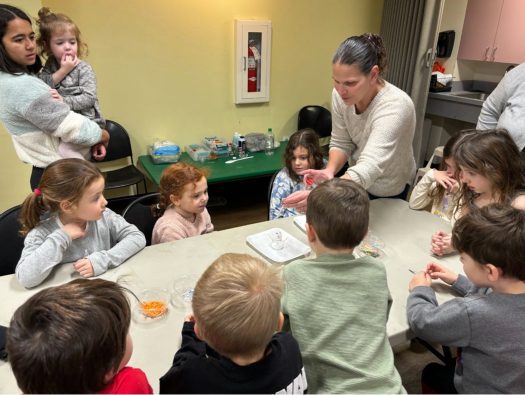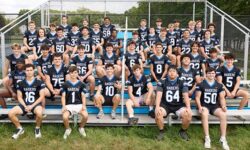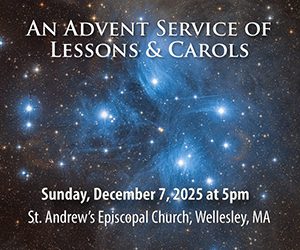By Madison Butkus
Hometown Weekly Reporter
The Walpole Coordinated Family & Community Engagement Program (CFCE) stopped by the Dover Town Library (DTL) to have children participate in some winter STEM activities. Ages five and up were all welcome to come and enjoy the four different projects set up that involved them using their sensory motor, predicting, and fine motor skills.
Little ones and their guardians packed the Community Room of the DTL, eager to participate in this hand-on activities. At the start of the program, Walpole CFCE Grant Coordinator Yvette Sammarco gathered everyone around the table to conduct a predictions experiment. There were six cups set up with an ice cube in each and the goal was to predict which ice cube would melt the fastest depending on what was added to it. For the six individual cups, kiddos added sand to one cup, salt in another, hot water in the third, sugar in the fourth, cold water in the fifth, and nothing to the sixth cup. Walpole CFCE volunteer, Nikki Cataloni, passed out pieces of paper and markers for everyone to write down their guesses as to which would melt the fastest and they would check back in about 15 minutes to see.
While waiting for the ice to melt, little ones were able to participate in three other amazing activities set up around the room. The first was another predictions type of experiment in which kiddos would use markers to color in a cutout of a boot. Then using some tape, they would attach a piece of paper towel, cloth, and plastic bag to any part of the boot. Using a pipet, they would then add a drop of water to each to see which one made the boot waterproof.
The second activity was based around fine motor skills and had the children creating different shapes using mini marshmallows and toothpicks. On the table was a print out of some ideas that they could potentially build and how many of each item they would need to do so. Many of the little ones created both 2D and 3D sculptures, including cubes, pyramids, rectangles and more.
The third and final activity was a major hit amongst all the young attendees. It involved getting their hands a little dirty and sharpening their sensory motor skills. By combining baking soda and shaving cream, Nikki created some fake snow in which everyone was able to build their own snowman. As an added perk, they could even decorate their snowman with carrot noses and small googly eyes. Once each snowman was created, the children would use a pipet and add some droplets of vinegar on top. This would cause the snowman to fizz up and ultimately ‘melt’ away.
Each of these activities not only allowed little ones to have a fun time, but encouraged them to learn about various scientific concepts. Everyone was fascinated about what they could create and wanted to recreate these types of activities at home. Before leaving for the day, little ones found out that hot water melts ice the fastest, many of which predicted that this would be the case. As a final farewell, Yvette shared some interesting science facts and recapped what they all learned throughout this program.
























